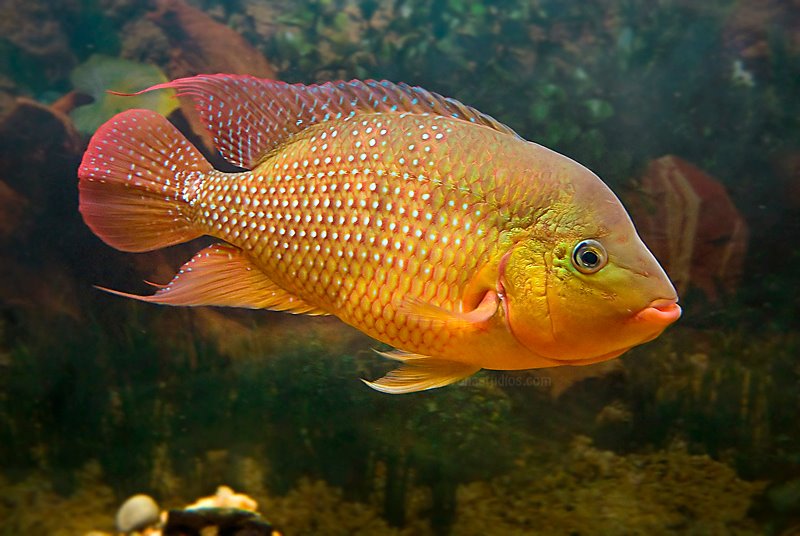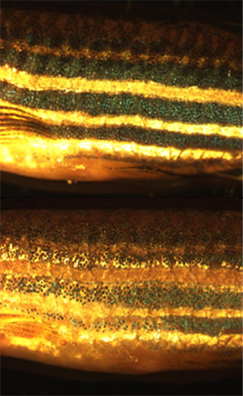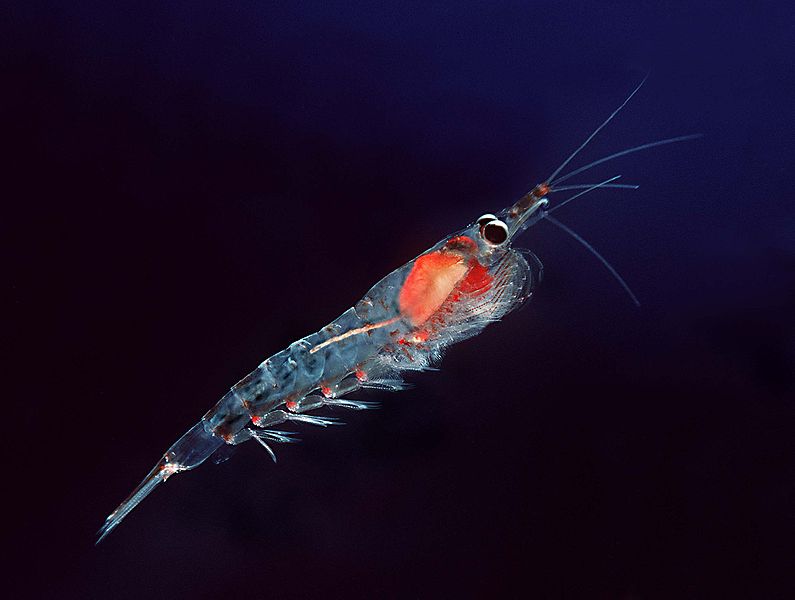 Dedicated aquarists pour their hearts and souls into creating thier own versions of breathtaking aquatic displays. Countless hours are dedicated to precise placement of wood, rock and other ornaments, painstaking pruning of live plants, and, of course, to testing and maintaining the water quality to provide the healthiest environment possible for the stars of the show: the fish! The ultimate goal is to have brilliant, beautiful, healthy fish to observe, and just about every other aspect of the tank contributes to the appearance of the livestock you keep. While the conditions that favor each species vary, you can provide the necessary factors to tweek the colors they show and make your fish look their best.
Dedicated aquarists pour their hearts and souls into creating thier own versions of breathtaking aquatic displays. Countless hours are dedicated to precise placement of wood, rock and other ornaments, painstaking pruning of live plants, and, of course, to testing and maintaining the water quality to provide the healthiest environment possible for the stars of the show: the fish! The ultimate goal is to have brilliant, beautiful, healthy fish to observe, and just about every other aspect of the tank contributes to the appearance of the livestock you keep. While the conditions that favor each species vary, you can provide the necessary factors to tweek the colors they show and make your fish look their best.
Understanding Fish Coloration
The inner layer of each fish’s skin contains color cells called chromatophores. Some chromatophores produce melanin, providing brown or black pigmentation. Some are capable of storing carotenoids which provide brilliant red, orange, and yellow pigments that come largely from foods the animals eat. Then there are iridophores, that contain crystalline deposits that reflect and bend light and giving the illusion of silvery, white, or metallic blue and green pigmentation.
 You may have noticed that these colors aren’t “fixed”. Your finned friends are able to change color if certain stimuli or conditions present themselves. Changes in environmental conditions, stressful situations, and during different breeding stages are just a few things that can make your fish dramatically shift colors. These color changes are governed by the fish’s own body, generally as mechanisms of defense or survival, allowing them to blend better with their environment when presented with a threat or other outside cue. The pic to the left show’s how the coloration of a Danio changed when placed into a tank with a black background. Notice how the chromatophores swelled to create darker, more solid stripes to help the fish blend.
You may have noticed that these colors aren’t “fixed”. Your finned friends are able to change color if certain stimuli or conditions present themselves. Changes in environmental conditions, stressful situations, and during different breeding stages are just a few things that can make your fish dramatically shift colors. These color changes are governed by the fish’s own body, generally as mechanisms of defense or survival, allowing them to blend better with their environment when presented with a threat or other outside cue. The pic to the left show’s how the coloration of a Danio changed when placed into a tank with a black background. Notice how the chromatophores swelled to create darker, more solid stripes to help the fish blend.
Now, if we put aside these rapid color changing capabilities, we can look more closely at the factors that can enhance or diminish their natural potential. Just like for you and I, genetics play a role in color potential. Baby fish will grow up to look like their parents (though genetic mutations and recessive traits may appear from time to time), and the better the color the parents have the better the potential for great looking offspring.
It’s up to you to feed your fish the right foods and keep them in an environment that will help to bring out their best. By providing the right conditions, you can help your fish to increase the amount of pigments and chromatophores they hold, thus making colors intense and long lasting.
What Can I Do?
First and foremost, make yourself familiar with the natural habitat and conditions of the fish you’re keeping. By creating living conditions that make your fish comfortable and happy, you begin with the right stuff to make your fish look their best. Start by considering the chemistry your fish prefer. If you put a fish that prefers a more alkaline environment, such as African Cichlids, into a tank with water on the soft side he may never reach his full color potential.
Chemistry and Tank Decor
 If you have your thumb on the ideal chemistry, the furnishings and decor of the tank should be your next ingredient. Fish that tend to be timid and prefer plenty of cover to feel secure will probably be stressed in an open environment. If they are skittish and frightened, chances are their colors will remain muted and pale in an effort to blend and feel safe. By providing plants, wood, rocks, or ornaments that allow them cover, these fish will develop a sense of security in their space becoming less stressed and able to concentrate more on behaviors like courting and spawning as opposed to survival. Ornaments and tank decor also allows fish to establish territory, so if you have multiple pairs in the tank and plenty of room, color is more likely to develop on more than a single dominant male.
If you have your thumb on the ideal chemistry, the furnishings and decor of the tank should be your next ingredient. Fish that tend to be timid and prefer plenty of cover to feel secure will probably be stressed in an open environment. If they are skittish and frightened, chances are their colors will remain muted and pale in an effort to blend and feel safe. By providing plants, wood, rocks, or ornaments that allow them cover, these fish will develop a sense of security in their space becoming less stressed and able to concentrate more on behaviors like courting and spawning as opposed to survival. Ornaments and tank decor also allows fish to establish territory, so if you have multiple pairs in the tank and plenty of room, color is more likely to develop on more than a single dominant male.
Lighting on the tank should also be carefully considered. Fish from murky rivers don’t tend to like bright lighting, as they feel too exposed. The color and intensity of the bulbs you choose will make a big impact not only on the comfort of your stock, and it can also make a huge difference in their appearance. Cool blue lighting and warm natural sunlight hues may make a fish look totally different to your eye. Experiment with different lighting effects to find just the right mix and really make your fish pop!
Tankmates
Choosing the wrong tankmates can also ruin your fish’s sense of security and a stressful environment. Fish that might intimidate or bully other fish in the tank may look great themselves, but will send others to cower under rocks or, worse yet, may sustain physical damage from a dominant male or more aggressive species. Research tankmates carefully and be sure to watch the daily interactions of your fish as they are introduced and/or mature in the tank.
Diet
 Everyone has heard the saying “you are what you eat”. Well many fish create and maintain their brilliant red, yellow and orange coloration from pigments they get from the things they eat. Natural food items like krill, daphnia, brine shrimp, even insects, all rich in carotenoids are the best think you can offer fish to enhance their color, and the fresher the better. Most of us don’t have the time or money to maintain live food pools of these critters, but they are commercially available frozen and freeze dried. The goal is to offer foods as close to those they would consume in the wild as possible, with as much variety as possible, too. Color-enhancing commercial foods may cotribute enough to make your fish look good, but natural foods contribute the perfect recipe to create vibrant colors fish would have in their natural habitat.
Everyone has heard the saying “you are what you eat”. Well many fish create and maintain their brilliant red, yellow and orange coloration from pigments they get from the things they eat. Natural food items like krill, daphnia, brine shrimp, even insects, all rich in carotenoids are the best think you can offer fish to enhance their color, and the fresher the better. Most of us don’t have the time or money to maintain live food pools of these critters, but they are commercially available frozen and freeze dried. The goal is to offer foods as close to those they would consume in the wild as possible, with as much variety as possible, too. Color-enhancing commercial foods may cotribute enough to make your fish look good, but natural foods contribute the perfect recipe to create vibrant colors fish would have in their natural habitat.
Red Terror image referenced from wikipedia and originally posted by VoneDaddy
Northern Krill image referenced from wikipedia and originally posted by Uwe Kils
 That Fish Blog – Aquarium Advice and Information
That Fish Blog – Aquarium Advice and Information
